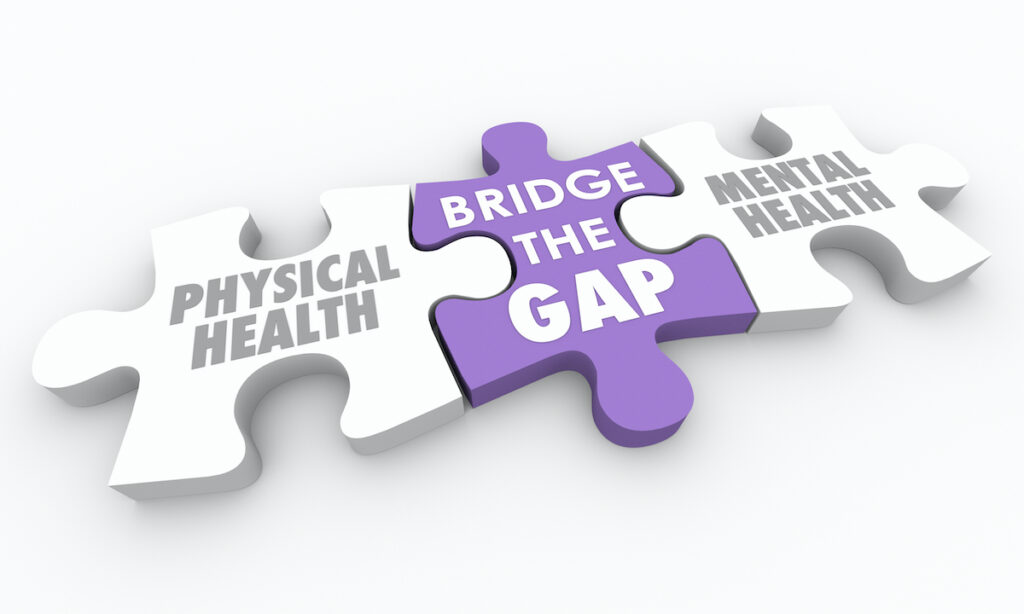
The relationship between chronic physical morbidity and severe mental illness is well established and known to sadly reduce life expectancy and life quality (Firth et al., 2019).
This is part of a much wider conversation that includes the physical health inequalities that exist within primary care, with findings that physical health concerns start earlier and become more complex, more quickly for those with a severe mental illness (see this blog). Other related issues include whether general health advice is as useful for those with severe mental illness (see this blog) and concerns that whilst integrated care may seem like a clear answer, there are significant problems with these models in practice that need to be overcome (see this blog). These related issues show a clear need for the relationship between physical and mental health to be explored in more depth.
There is a gap in the literature, therefore, to understand the temporal relationship between severe mental illness and chronic physical health problems. A recent study by Naomi Launders, Dr Joseph Hayes and colleagues aimed to investigate which physical health conditions develop more commonly before, after and at the point of diagnosis of a severe mental illness, which can inform diagnostic, preventative and treatment interventions (Launders et al, 2022).

People with severe mental illness are at an elevated risk of a range of chronic physical health problems.
Methods
The researchers identified patients from the UK Clinical Practice Research Datalink (CPRD) with a diagnosis of severe mental illness between 2000 and 2018, via medical codes for schizophrenia, bipolar disorder, or other non-affective psychotic illnesses. Each patient was matched with up to four individuals without severe mental illness by sex, 5-year age band, primary care practice, and year of primary care practice registration.
The authors examined 24 physical health outcomes, based on the Charlson and Elixhauser comorbidity indices, as well as the prevalence cross-sectionally at 5 years, 3 years, and 1 year before severe mental illness diagnosis, at the point of diagnosis, and 1 year, 3 years, and 5 years after diagnosis, using logistic regression. Finally, the researchers conducted a subgroup analysis to divide the severe mental illness cohort by diagnosis.
Results
A higher percentage of people with a severe mental illness had at least one or more chronic physical health problem at time of diagnosis and at the 5-year follow-up, in comparison with their matched counterparts. The most prevalent conditions were asthma, hypertension, diabetes, neurological disease, and hypothyroidism.
Other key findings include:
- Of the 24 physical health conditions included in this research, at the point of diagnosis, people with schizophrenia had a higher likelihood of developing five of the chronic physical conditions and a lower likelihood of developing nine of the conditions than the matched controls.
- For individuals with bipolar disorder and other psychoses, at the point of diagnosis, higher odds were found for both groups in developing 15 of the conditions, than for those without a serious mental illness.
- At 5 years after diagnosis, higher odds of having 13 of the conditions were found for people with schizophrenia, compared to the matched controls. At this time point, results similarly revealed higher odds for 19 of the conditions for those with bipolar disorder and an increased likelihood of having 16 of the conditions for those in the other psychosis group.

The most prevalent conditions among people with severe mental illness were asthma, hypertension, diabetes, neurological disease, and hypothyroidism.
Conclusions
This research highlights an important point, that there is an elevated risk of several chronic physical conditions at the point of diagnosis of a severe mental illness as well as 5 years after. The researchers reveal that this differs by mental illness which may be because physical conditions are under-recorded in patients with schizophrenia relative to patients with other severe mental illness.
The authors concluded that:
Elevated odds of multiple conditions at the point of severe mental illness diagnosis suggest that early intervention on physical health parameters is necessary to reduce morbidity and premature mortality.

People with severe mental illness are at an elevated risk of a range of chronic physical health problems, not just later in life, but also at the point they are first diagnosed with mental illness.
Strengths and limitations
One limitation of this research is that the factors that may be responsible for the increased prevalence of physical health conditions in people with severe mental illness were not studied, leaving an incomplete picture and many unanswered questions. These include whether results are related to risk factors, as other studies have suggested, or underdiagnosis of physical health conditions among those severe mental illness. Another consideration is directionality. If chronic health conditions exist prior to a severe mental illness diagnosis, could it be that the symptoms of such conditions contribute to the development of a serious mental illness? A follow-up study feels necessary to further explain these results.
A second limitation is the confounding variables such as socioeconomic status that limit the validity of the study. Although researchers attempted to manage this by matching patients within the same primary care practice, not all individuals residing in the same area will be of the same socio-economic position. Certainly, there is a correlation between socioeconomic inequalities and mental health problems (Reiss, 2013) that cannot be ignored.
However, this research has several strong points, including the large representative sample and value added to the current literature. The researchers found that several physical health conditions were present at the point of severe mental illness diagnosis, whilst previous research has associated severe mental illness with increased risk for physical illness over long time periods. Similarly, some conditions, such as increased prevalence of liver disease have been put down to the effects of psychotropic medication (Braude et al., 2021), but this study suggests that the picture may be more complicated.
Implications for practice
Certain conditions are seemingly under-diagnosed at the point of schizophrenia diagnosis, possibly resulting from under-investigation or diagnostic overshadowing, which is more common among this group (Jones, Howard & Thornicroft, 2008). This is a widespread issue with data suggesting that at the end of 2021, a mere 35% of people with severe mental illness received annual health checks (NHS England, 2020). This points to the need for improvement in the monitoring, screening and diagnosis of physical health conditions for individuals with severe mental illness.
It is important to highlight that a crucial period for physical health interventions for those with severe mental illness is currently being missed. It is often assumed that physical health problems are related to the course of the severe mental illness itself, the drug treatment or lifestyle risk factors. However, this research emphasises the importance of early intervention, even more so given the finding that the current interventions for managing risk factors have been found to be less effective for this group (Baxter et al., 2016).
It is hopeful that modest improvements in physical health outcomes for individuals under the care of early-intervention services have been found over the past 10 years (Williams et al., 2022) and this type of relationship is vital for accelerating this trend.

Chronic health problems should not be viewed as inevitable for people with severe mental illness. Prevention and early intervention are key.
Statement of interests
None to declare.
Links
Primary paper
Launders, N., Kirsh, L., Osborn, D. P., & Hayes, J. F. (2022). The temporal relationship between severe mental illness diagnosis and chronic physical comorbidity: a UK primary care cohort study of disease burden over 10 years. The Lancet Psychiatry, 9(9), 725-735.
Other references
Baxter, A. J., Harris, M. G., Khatib, Y., Brugha, T. S., Bien, H., & Bhui, K. (2016). Reducing excess mortality due to chronic disease in people with severe mental illness: meta-review of health interventions. The British Journal of Psychiatry, 208(4), 322-329.
Bell, A. (2018, October 25). Physical Health Inequalities in Primary Care.
Braude, M. R., Con, D., Lubel, J., Bidwai, A., Nguyen, H. T., Sharmamiglani, S., … & Sievert, W. (2021). Liver disease prevalence and severity in people with serious mental illness: a cross-sectional analysis using non-invasive diagnostic tools.Hepatology International, 15(3), 812-820. (SpringerLink abstract).
England, N. H. S. (2020). Physical Health Checks for people with Severe Mental Illness. Physical Health Checks SMI Q4 2019–2020.
Firth, J., Siddiqi, N., Koyanagi, A. I., Siskind, D., Rosenbaum, S., Galletly, C., … & Stubbs, B. (2019). The Lancet Psychiatry Commission: a blueprint for protecting physical health in people with mental illness. The Lancet Psychiatry, 6(8), 675-712.
Hughes, L. (2016, September 13). Integrated care for physical health in severe mental illness.
Jones, S., Howard, L. and Thornicroft, G. (2008). “‘diagnostic overshadowing’: Worse physical health care for people with mental illness,” Acta Psychiatrica Scandinavica, 118(3), pp. 169–171.
Knowles, S. (2014, June 16). We don’t know if general health advice improves physical health for patients with serious mental illness.
Reiss, F. (2013). Socioeconomic inequalities and mental health problems in children and adolescents: a systematic review. Social science & medicine, 90, 24-31. (Science Direct abstract).
Williams, R., Natkulasingam, S., Tooke, B., Webster, E., Quirk, A., Gupta, V., … & Crawford, M. J. (2022). Examining the effects of national initiatives to improve the physical health of people with psychosis in England: secondary analysis of data from the National Clinical Audit of Psychosis. BJPsych bulletin, 46(3), 140-147.
Photo credits
- Photo by Sahej Brar on Unsplash
- Photo by Towfiqu barbhuiya on Unsplash
